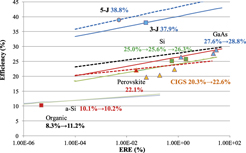Crossref Citations
This article has been cited by the following publications. This list is generated based on data provided by
Crossref.
Yamaguchi, Masafumi
Lee, Kan-Hua
Araki, Kenji
and
Kojima, Nobuaki
2018.
A review of recent progress in heterogeneous silicon tandem solar cells.
Journal of Physics D: Applied Physics,
Vol. 51,
Issue. 13,
p.
133002.
Yamaguchi, Masafumi
Zhu, Lin
Akiyama, Hidefumi
Kanemitsu, Yoshihiko
Tampo, Hitoshi
Shibata, Hajime
Lee, Kan-Hua
Araki, Kenji
and
Kojima, Nobuaki
2018.
Analysis of future generation solar cells and materials.
Japanese Journal of Applied Physics,
Vol. 57,
Issue. 4S,
p.
04FS03.
Araki, Kenji
Lee, Kan-Hua
and
Yamaguchi, Masafumi
2018.
Opportunities for breaking an energy generation limit of photovoltaic using multijunction and super-multijunction cells.
p.
1.
Araki, Kenji
Ji, Liang
Kelly, George
and
Yamaguchi, Masafumi
2018.
To Do List for Research and Development and International Standardization to Achieve the Goal of Running a Majority of Electric Vehicles on Solar Energy.
Coatings,
Vol. 8,
Issue. 7,
p.
251.
Yamaguchi, Masafumi
Lee, Kan-Hua
Araki, Kenji
Kojima, Nobuaki
and
Ohshita, Yoshio
2018.
Analysis for efficiency potential of crystalline Si solar cells.
Journal of Materials Research,
Vol. 33,
Issue. 17,
p.
2621.
Zhu, Lin
Lee, Kan‐Hua
Yamaguchi, Masafumi
Akiyama, Hidefumi
Kanemitsu, Yoshihiko
Araki, Kenji
and
Kojima, Nobuaki
2019.
Analysis of nonradiative recombination in quantum dot solar cells and materials.
Progress in Photovoltaics: Research and Applications,
Vol. 27,
Issue. 11,
p.
971.
Yamaguchi, Masafumi
Lee, Kan-Hua
Araki, Kenji
Kojima, Nobuaki
masuda, Taizo
Kimura, Kazutaka
and
Satou, Akinori
2019.
Proposals for Accelerating Photovoltaics Installations in Japan and Further Developments of Science and Technologies of Photovoltaics.
p.
1724.
Yamaguchi, Masafumi
and
Araki, Kenji
2019.
Encyclopedia of Sustainability Science and Technology.
p.
1.
El-Khozondar, Hala J.
Alshembari, Ahmed A.
Shabat, Mohammed M.
and
Koch, Alexander W.
2019.
Two layers corrugated semiconductor solar cell.
Optik,
Vol. 181,
Issue. ,
p.
933.
Jiang, Shaoliang
Chen, Yaqian
Li, Yujin
and
Han, Liang
2019.
Novel D-D-π-A indoline-linked coumarin sensitizers for dye-sensitized solar cells.
Journal of Photochemistry and Photobiology A: Chemistry,
Vol. 384,
Issue. ,
p.
112031.
Araki, Kenji
Ota, Yasuyuki
Saiki, Hiromu
Tawa, Hiroki
Nishioka, Kensuke
and
Yamaguchi, Masafumi
2019.
Super-Multi-Junction Solar Cells—Device Configuration with the Potential for More Than 50% Annual Energy Conversion Efficiency (Non-Concentration).
Applied Sciences,
Vol. 9,
Issue. 21,
p.
4598.
Yamaguchi, Masafumi
Lee, Kan-Hua
Araki, Kenji
Kojima, Nobuaki
Okuno, Yasuki
and
Imaizumi, Mitsuru
2019.
Analysis for Radiation Degradation of Advanced Si Space Solar Cells.
p.
2377.
Azzouzi, Mohammed
Cabas-Vidani, Antonio
Haass, Stefan G.
Röhr, Jason A.
Romanyuk, Yaroslav E.
Tiwari, Ayodhya N.
and
Nelson, Jenny
2019.
Analysis of the Voltage Losses in CZTSSe Solar Cells of Varying Sn Content.
The Journal of Physical Chemistry Letters,
Vol. 10,
Issue. 11,
p.
2829.
Yamaguchi, Masafumi
Araki, Kenji
Kojima, Nobuaki
and
Ohshita, Yoshio
2020.
Overview and Loss Analysis of High-Efficincy III-V Compound Single-Junction Solar Cells.
p.
0149.
Araki, Kenji
Ota, Yasuyuki
Saiki, Hiromu
Tawa, Hiroki
Nishioka, Kensuke
Sato, Daisuke
and
Yamaguchi, Masafumi
2020.
Super-multi-junction solar cells - Device configuration with the potential for more than 50% annual energy conversion efficiency (CPV).
Vol. 2298,
Issue. ,
p.
020001.
Yamaguchi, Masafumi
Araki, Kenji
Kojima, Nobuaki
Takamoto, Tatsuya
Masuda, Taizo
Satou, Aknori
Yamada, Kazzumi
and
Yamazaki, Mitsuhiro
2020.
Importance of Developing High-Efficiency Solar Cells for PV-Powered Vehicles.
p.
0221.
David, Thamyres Machado
Silva Rocha Rizol, Paloma Maria
Guerreiro Machado, Marcela Aparecida
and
Buccieri, Gilberto Paschoal
2020.
Future research tendencies for solar energy management using a bibliometric analysis, 2000–2019.
Heliyon,
Vol. 6,
Issue. 7,
p.
e04452.
Nakamura, Tetsuya
Imaizumi, Mitsuru
Akiyama, Hidefumi
and
Okada, Yoshitaka
2020.
Practical target values of Shockley–Read–Hall recombination rates in state‐of‐the‐art triple‐junction solar cells for realizing conversion efficiencies within 1% of the internal radiative limit.
Progress in Photovoltaics: Research and Applications,
Vol. 28,
Issue. 5,
p.
417.
Yamaguchi, Masafumi
Lee, Kan-Hua
Sato, Daisuke
Araki, Kenji
Kojima, Nobuaki
Takamoto, Tatsuya
Masuda, Taizo
and
Satou, Akinori
2020.
Overview of Si Tandem Solar Cells and Approaches to PV-Powered Vehicle Applications.
MRS Advances,
Vol. 5,
Issue. 8-9,
p.
441.
Yamaguchi, Masafumi
Lee, Kan‐Hua
Araki, Kenji
Kojima, Nobuaki
Okuno, Yasuki
and
Imaizumi, Mitsuru
2021.
Analysis for nonradiative recombination loss and radiation degradation of Si space solar cells.
Progress in Photovoltaics: Research and Applications,
Vol. 29,
Issue. 1,
p.
98.




